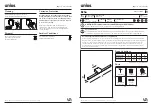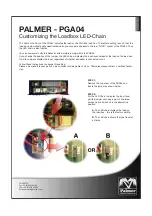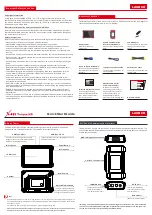
ISCOM070-1809
Mod.
VE 502E
Description
MAX
E
E
C
B
20M
2M
200K
20K
2K
PNP
10A
200mA
20mA
2mA
200
200
2V
20V
V
600V
1000V
CAT.
CAT.
FUSED
MAX 10A
10A
COM
DC1000V/0.2A
DC750V/0.2A
V
Ω
A/mA
Ω
OFF
BLCTR
HOLD
1000V
750V
200V
mV
200 A
NPN/LED
A
Ω
VE 502E
DC/AC
1.
4.
2.
5.
6.
7.
9.
3.
8.
1.
Backlit LCD Display
2.
Backlit Button
3. Hold
Button
4.
AC/DC Button
5.
Rotary Switch For Function Selection
6.
Socket For Test Transistor
7.
Jack
VΩµA/mA
8.
Jack 10A
9.
Jack COM
User Manual
DIGITAL TESTER
Read all the instructions carefully
Digital tester for measurement of: AC/DC voltage, AC/DC current, resistance, diode test, transistor 2 LED test,
continuity test.
It is designed for the professional at work in the field or laboratory and for in-door use.
Code Model
Description
VE772600
VE 502E
Digital tester
GENERAL CHARACTERISTICS
•
Maximum Indication: 1999 counts (3 1/2 digits) with large LCD display.
•
Accuracies are ± (% r No. of digits)
•
Sampling rate: 2-3 times reading per second (approximate).
•
Push-type Switch buttons respectively for Data Hold-on(HOLD), Back-lighting(BLCTR) and AC/
DC (Interchange.)
•
Single 20 positions easy to use rotary switch for Ten Functions and Range selection.
•
High sensitivity of 100µV.
•
Impedance: 10MΩ
on all DCV & ACV Ranges.
•
Automatic over-range indication with the “1” displayed.
•
Automatic low battery power (6.4V) indication with the battery symbol "LOBAT".
•
Automatic polarity indication on DC ranges.
•
Diode testing with 1mA fixed current.
•
Transistor hFE Test With ib-10µA.
•
Continuity Test by beeper sounding below 50 ohm.
•
Maximum common mode voltage: 380V DC/AC rms.
•
Environment for guaranteed accuracy: 23°C±5°C, less than 75% RH.
•
Temperature Scope: Operating 0°C to 40°C, 32 °F to 104 °F. Max. RH 80% to 31°C
decreasing linear to 50% RH at 40°C.
•
Storage: -10 °C to 50°C, 14 °F to 122 °F at < 80% relative humidity.
•
Power Supply: One 6F22 9-volt battery or equivalent.
•
Size & Weight: 74(W) x 145(D) x 40(D) mm and 240g (including battery).
•
Accessories: Operating manual, 1 Set of test leads with 20AWG 1000V Class PVC Wire.
•
This instrument complies with insulation category (over voltage category), CAT II 1000V, CAT III
600V.
•
Pollution degree 2 in accordance with IEC-664
Function
Test Leads connected
Overload Maximum
V/DC
V/OHM + COM
1000V DC
V/AC
V/OHM + COM
750V rms. AC
OHM
V/OHM + COM
380V DC/AC Protected
A/DC, AC
A + COM
0.5A 250V DC/AC
10A/DC, AC
10A + COM
10A 250V DC/AC
Diode, Buzz
V/OHM + COM
380V DC/AC Protected
hFE/LED
Special Transistor Sockets
1000
OPERATIONS
SAFETY WARNINGS AND CAUTIONS
1. Check the 9-volt battery by setting the range switch to any other range but Off. If the battery
is weak a sign will appear on the display. If this does not appear on the display proceed as
below. See MAINTENANCE if the battery has to be replaced.
2. The mark or sign
next to the test lead jacks warns that the input voltage or current
should not exceed the indicated values. This is to prevent damage to the internal circuit.
3. The function switch should be set to the range to be tested before operation.
4. If the voltage or current range is not known beforehand set the RANGE switch to a high range
and work down.
5. When only the figure “ 1” is displayed, over-range is being indicated, and the FUNCTION
switch must be set to a higher range.
6. Do not measure large current 10 amp lasting more than 15 seconds. This can cause damage
to the instrument and or equipment being tested and or injury to the user.
7. To avoid electric shock, disconnect measuring terminals before removing back cover.
DC Voltage Measurement
1. Connect the BLACK test lead to the COM jack and the RED test lead to the
VΩµA/mA
jack.
2. Make sure that the AC/DC switch Button is on DC position (UP).
3. Set the FUNCTION switch to the V range to be used and connect the test leads across the
source or load under measurement. The polarity of the RED lead connection will be indicated
at the same as the voltage.
4. Get the readings from the LCD.
Note: Do not apply more than 1000V at all ranges to the input. Indication is possible at higher
voltages, but there is danger of damaging the internal circuit.
Range
Accuracy
Resolution
Over load Protection
200mV
± (0.5% of rdg. +1 digit)
100µV
DC 1000V
AC 750V rms.
2.000V
± (1.0% of rdg. +2 digits)
1mV
20.00V
10mV
200.0V
100mV
1000V
± (1.5% of rdg. +2 digits)
1V
AC Voltage Measurement
1. Connect the BLACK test lead to the COM jack and the RED test lead to the
VΩµA/mA
jack.
2. Push down the AC/DC switch Button. Then all the ranges of voltage are AC type.
3. Set the FUNCTION switch to the V range to be used and connect the test leads across
the source or load under measurement.
4. Get the readings from the LCD.
Note: Do not apply more than 300V at 200mV range and 750V rms. at other ranges to
the input. Indication is possible at higher voltages, but there is danger of damaging the
internal circuitry.
Range
Accuracy
Resolution
Over load Protection
200mV
± (1.0% of rdg. +3 digit)
100µV
DC 1000V
AC 750V rms.
2V
± (1.5% of rdg. +3 digits)
1mV
20V
10mV
200V
100mV
750V
± ( 2.5% of rdg. +4 digits)
1V
Frequency Range: 40Hz to 1000Hz
DC Current Measurement
1. Connect the BLACK test lead to the COM jack and the RED test lead to the
VΩµA/mA
jack for Current Maximum of 400mA (Note: The polarity of the RED test lead is “+”).
For a maximum of 10A, move the red test lead to the 10A jack.
2. Make sure that the AC/DC switch Button is on DC position(UP)
3. Set the FUNCTION switch to the A range to be used and connect the test leads in series
with the load under measurement.
4. Get the readings from the LCD.
Note: A. The Maximum input current is 0.5A or 10A depending on the jack used.
Excessive current will blow the fuse that must be replaced. Another fuse 10A protects
the 10A range. The fuse rating should be 0.5A or no more than 10A to prevent damage
to the internal circuit. The Maximum terminal voltage drop is 200mV except for the 10A
range.
Range
Accuracy
Resolution
200µA
± (1.2% of rdg. +1 digit)
100nA
2mA
1µA
20mA
10µA
200mA
100µA
10A
± (2.0% of rdg. +3 digits)
10mA
Overload Protection: Diode & 0.5A/250V Fuse of ordinary glass tube type but 10A range with 10A/250V
fuse of ordinary glass tube type.
AC Current Measurement
1. Connect the BLACK test lead to the
COM
jack and the RED test lead to the
VΩµA/mA
jack for a maximum of 0.2A. For a maximum of 10A, Move the RED test lead to the 10A
jack.
2. Push down the AC/DC switch Button. Then all the ranges of current are AC type.
3. Set the FUNCTION switch to the A range to be used and connect the test lead in series
with the load under measurement.
4. Get the readings from the LCD.
Note: A. The Maximum input current is 0.2A or 10A depending upon the jack used.
Excessive current can blow the fuse. Another fuse 10A protects the 10A Range. The fuse
rating should be 0.5A or no more than 10A to prevent damage to the internal circuit. The
maximum terminal voltage drop is 200mV except for the 10A range.
Range
Accuracy
Resolution
200µA
± (1.5% of rdg. +3 digit)
100nA
2mA
1µA
20mA
10µA
200mA
100µA
10A
± (2.5% of rdg. +5 digits)
10mA
Overload Protection: Diode & 0.5A/250V Fuse of ordinary glass tube type, but 10A range with 10A/250V
fuse of ordinary glass tube type. Frequency Range: 40Hz to 1000Hz. Indication: Average (rms. of sine
wave).
Resistance Measurement
1. Connect the BLACK test lead to the
COM
j jack and the RED test lead to the
VΩµA/
mA
jack (Note: The polarity of the RED test lead is
“+”
)
2. Set the FUNCTION switch to the
Ω
range to be used and connect the test leads across
the resistance under measurement.
3. Get the readings from the LCD.
Note:
1. If the resistance value being measured exceeds the maximum value of the range
selected, an over-range indication will be displayed (“1”), then select a higher range.
For resistance of approximate 1M ohm and above the Meter may take a few seconds to
become stable. This is normal for high resistance readings.
2. When the input is not connected i.e. at open circuit the figure “1” will be displayed for
the over-range condition.
3. When checking in-circuit resistance, be sure the circuit under test has all power
removed and that all capacitors are fully discharged.
Range
Accuracy
Resolution
Overload Protection by PTC
200 ohm
± (1.2% of rdg. +2 digit)
0.1 ohm
MAX
DC/AC 380V rms.
2K ohm
± (1.0% of rdg. +2 digits)
1 ohm
20K ohm
10 ohm
200K ohm
100 ohm
2M ohm
1K ohm
20M ohm
± (2.5% of rdg. +4 digits)
10K ohm
Overload Protection by PTC: Max. AC/DC 380V rms.
Diode Measurement
1. Connect the BLACK test lead to the
COM
jack and the RED test lead to the
VΩµA/mA
jack. (Note: The polarity of the RED test lead is
“+”
)
2. Set the FUNCTION switch to the
range and connect the test leads across the
diode under measurement. Display shows the approximate forward working voltage of
this
. Overload protection by PTC against high Voltage across Max. DC/AC 380V
rms. at this Diode range.
Continuity Test
1. Connect the BLACK test lead to the
COM
jack and the RED test lead to the
VΩµA/mA
2. Set the FUNCTION switch to the
D range and the LCD will show the
approximate resistance of the circuit.
3. Connect the test leads to two points of circuit. If the resistance is lower than approx. 50
ohm, the buzzer sounds. Overload protection by PTC against high Voltage across Max.
DC/AC 380V rms. at this range.
Transistor hFE & LED Test
1. Set the Range switch to the "NPN/LED" to measurement LED or NPN transistor, to NPN to
measurement PNP transistor.
2. Determine whether the transistor is NPN or PNP and locate the Emitter, Base and
collector terminals. Insert the pins into the proper holes of the special socket on the front
panel.
3. The display will read the approximate hFE Value at the test condition Base
Current 10µ. VCE 2.8V.
4. Get the readings from the LCD.
5. For LED test, firstly set the Range switch to the “NPN” range, and then directly insert the
two poles of LED separately into the “E” & “C” jacks of the special hFE input sockets on the
front panel. A normal LED will be bright.
Back Lighting Operation
1. Set the Range switch to any range but
OFF.
2. Push the BLCTR button two seconds, and the LCD will be lit for easy reading
3. After 10 seconds, the light will turn off.
MAINTENANCE
Replacement for Batteries and/or Fuse should only be done after the test leads have been
disconnected and POWER OFF.
9-Volt Battery Replacement
Remove the screws from the back case of the meter, and lift off the rear case.
Remove the worn battery and replace with a new 9-volt 6F22 battery or equivalent.
Close the back case and tighten the screws.
Fuse Replacement
When current measurements are impossible, check if overload protection fuse blown.
There are two kinds of fuses. When the fuses need replacement, use only 0.5A/250V or
10A/250V fuses identical in physical size to the original.
CLEANING
To clean the device, use a damp cloth after having turned it off and removing the leads.
Do not use liquids, solvents or other products that can reduce the safety level of the device.
REFERENCE STANDARDS
Compliance with Community Directives:
2014/35/EU (LVD), 2014/30/EU (E.M.C.D.)
is declared in reference to the harmonized Standards
• EN 61010-1
• EN 61010-031
• EN 61326-1, EN 61326-2-2
0.5A/250v
10A/250v
This symbol on the product and/or accompanying documents
means that used electrical and electronic products should not
be mixed with general household waste.
For proper treatment, recovery and recycling, please take this
product to designated collection.






















